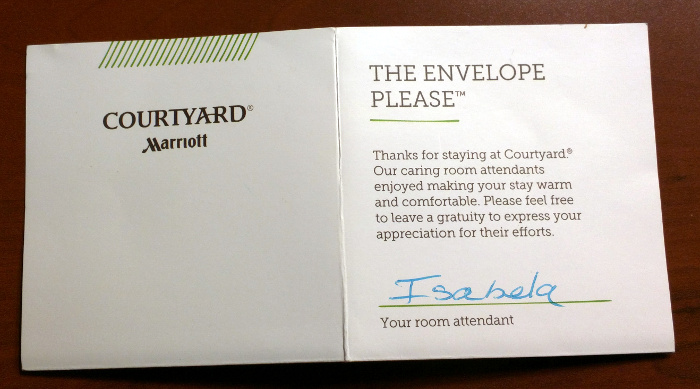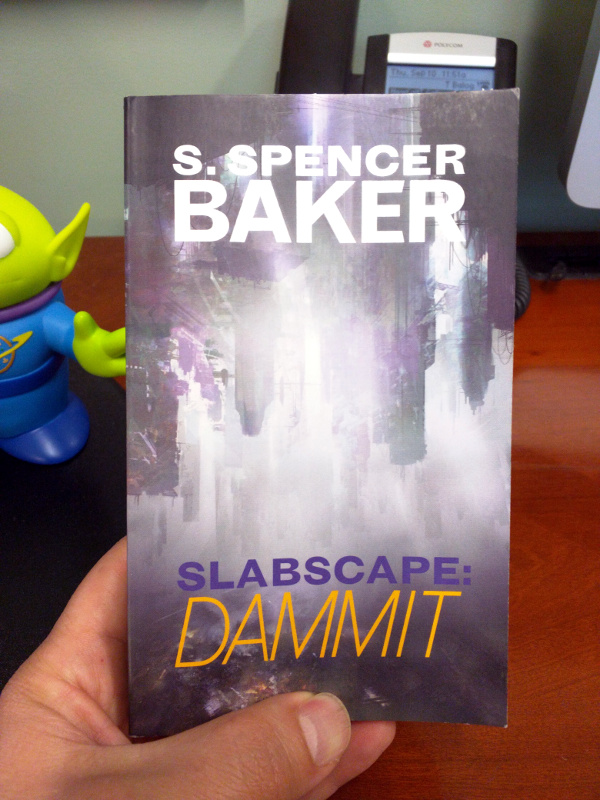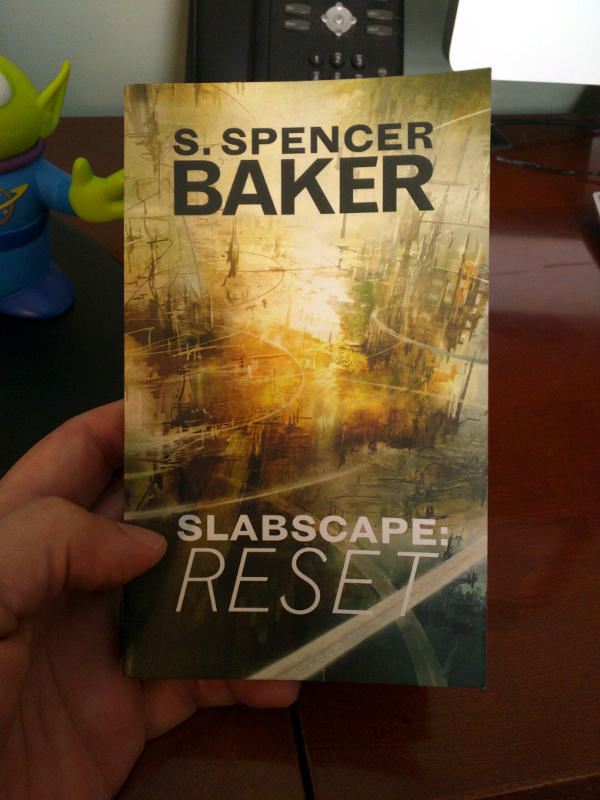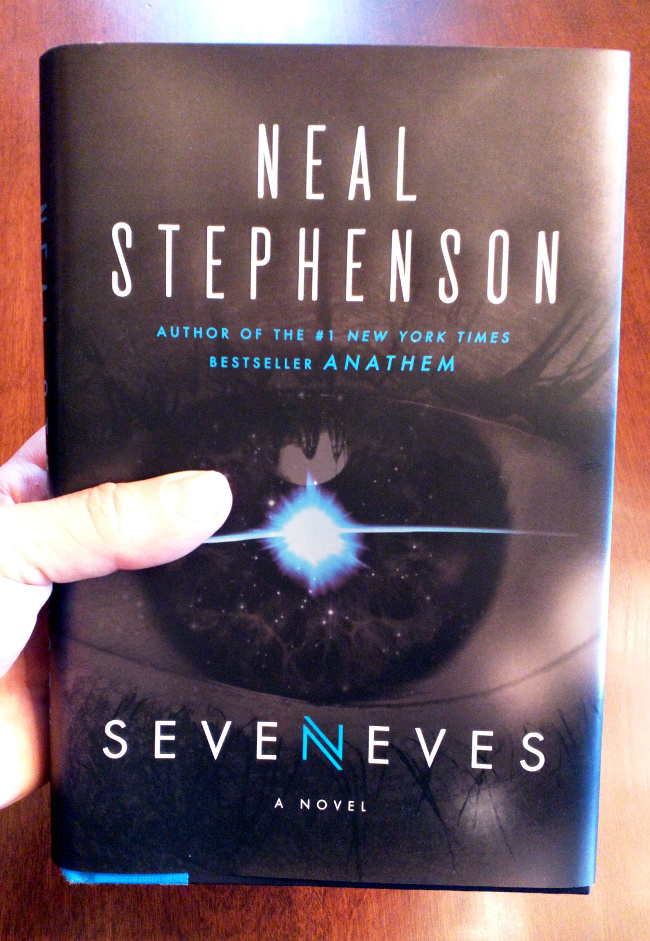I’ve had a visit to the Munich Oktoberfest on my bucket list for some time, and when it was announced that the OpenNMS Users Conference was going to be held in September, I decided this would be the year I went. There are quite a few German beer festivals held in the fall, but Oktoberfest is the largest and most well known. Yes, despite the name, it occurs mainly in September as it is scheduled to end the first weekend in October.
I arrived on a Thursday morning, as most flights from the US are overnight, and checked in to my hotel. My room wasn’t ready so I dropped off my bags and decided to head for the “Wiesn” – the main Oktoberfest grounds named after its location (Theresienwiese).

This sucker is huge.
Even on a Thursday morning there were lots of people about, and by Saturday there would be over one hundred thousand packed shoulder to shoulder on the grounds.
The best analogy for people in the US would probably be a State Fair. There are rides, including a huge ferris wheel, roller coasters and at least one haunted house:

There are food stalls stalls everywhere, including the famous “half meter bratwurst”:

as well as stalls selling souvenirs and booths to play games. But the area is dominated by ten huge beer “tents” from a variety of area brewers, along with several smaller tents as well.
Some friends of mine host a tech podcast called “Bad Voltage” and they were coming to do a show at the Users Conference, but they all wanted to come to Munich as I did. While Jono, Stuart and Ilan were showing up on Friday, Jeremy did what I did and came a day early, so through the wonders of modern mobile technology we were able to meet up on the Wiesn (near a huge ride called “Konga”).
Of course the first order of business was to obtain a beer. A serving of beer at Oktoberfest is called a maẞ (“mass”) and is served in a liter-sized glass mug. We picked a beer tent and entered to find it filled with thousands of like-minded people.

Since there were only two of us, we managed to find a seat at one of the large communal tables and within minutes we had a huge pretzel as well as huge beer each.
This was the first time I’d seen Jeremy since the SCaLE conference, so we spent the time catching up and taking in the crowd before getting up and seeking out our next beer in another tent.
I liked this tent the best, as we had nice people at our table (at this time of day on a Thursday most of the people were older – this would change on the weekend), a nice waitress named Julia and good food. Jeremy had a traditional dish called Schweinshaxe, or roasted pork knuckle, whereas I had Weißwurst (“white sausage”). I apparently was eating mine wrong so the friendly couple next to me demonstrated the proper way (you are supposed to remove the outer casing with a knife). By the time we were done with our beers I was in a good mood and was very happy I had come. The hotel called to let me know my room was ready but I didn’t want to leave, so it was off to the third tent.
This is when things started to go south.
Okay, I am nearly fifty years old, so I’ve been drinking for, what, almost thirty eight years or so. I know how alcohol affects me. I rarely drink to excess and at this point I figured I had about two more maß before I needed to quit. I was wrong.
We found a place at a table in the third tent and ordered another beer. I don’t remember much more than that. I know I bought a pin with the word “Boss” on it in the shape of the heart-shaped gingerbread cookies (Lebkuchenherz) popular at Oktoberfest. I can vaguely remember buying a hat and arguing it was too small (the lady went away and came back again, but the hat was still a “medium”). The best theory I have is that Jeremy slipped me a roofie, but to hear him tell it at some point in time I just got up and announced it was time for me to go.
This part was a bit frightening. I got lost and ended up wandering around Munich. At one time I remember looking at my phone and it told me I was an hour away from the hotel. Google showed me wandering around quite a bit.

But somehow I managed to make it back, and the next thing I remember is waking up, face down on the bed and fully clothed, in my hotel room. All of my bags were there, including a huge Pelican case with our telepresence robot, as was my passport, wallet and about as much money as I expected to have.
So, all in all not bad.
Needless to say, I slept in on Friday. I did manage to get out of the hotel around noon and meet up with Jeremy at the large, open air Viktualienmarkt. Munich is a beautiful city, so it was fun to wander around while slowly returning to being human.
The rest of our friends, including Stuart, Jono and Ilan, showed up late afternoon. We all met at their hotel, but as my friend Fanny was coming in too I left them to meet up with her at her hostel. She had lived in Munich for several months and wanted to get some traditional Bavarian food, so while the rest of the guys headed off to the Wiesn we went searching for a quieter place to eat.
We found a little restaurant that fit the bill and wasn’t too crowded. They had a band, which was actually pretty good, and I thought it was funny that in addition to traditional German songs they played some old American Pop.

This included a rendition of “Achy Breaky Heart”, but the crowd really got into a cover of John Denver’s “Take Me Home, Country Roads”. Combined with my continuing recovery from Thursday, I did feel a bit of cognitive dissonance.
But the food was good. I got Nürnburger sausages with sauerkraut while Fanny really wanted Obazta cheese. Both were good, but I thought it was funny than when I used the Google Translate mobile app to look at “Obazta” it translated that to “Obama”. I wasn’t fully recovered from the previous day so I drank Apfelschorle (apple juice and water) while Fanny had a beer. The waiter joked as he brought them to us that it was usually the other way around.
We then wandered over to the Wiesn to try to find the other guys, sampling a number of rides and attractions along the way. We never were able to find them – as I mentioned this place is huge and it was considerably more crowded than Thursday.
Fanny was very eager to find the Teufelsrad, or “Devil’s Wheel”, and after asking a number of people for directions we found it and were finally able to squeeze our way in. This is an old traditional attraction consisting of a large spinning wheel mounted in the floor. The “master of ceremonies” will call out certain requirements, such as “men in short lederhosen” and if you meet the requirements, you rush out and try to secure a good position near the center of the wheel. It then begins to spin, ultimately throwing off the riders until there is one left, who is the winner. You don’t win anything but pride, but man is it fun to watch.
The categories are funny, too. In addition to short lederhosen, long lederhosen and no lederhosen, there were a couple for only people over 50 and even one for men with a “penis less than 10cm long” – which both drew laughs from the crowd and a surprisingly large number of participants (with one man offering to prove himself before the crowd indicated that wouldn’t be necessary).
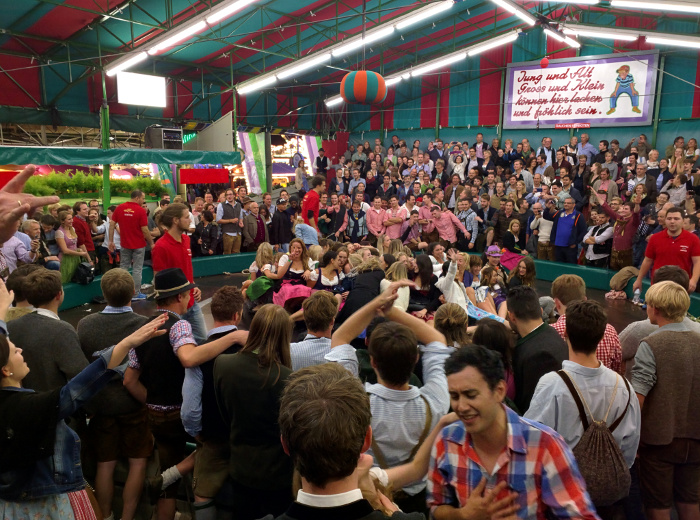
Woman participate as well, include those in the traditional Bavarian Dirndl dress. In fact, the best competitor of the evening was a young woman in just such a dress. See, even when you are the last rider of the wheel, they still have to get you off of it. They do this a number of ways. There is a large, pumpkin-shaped ball that they can drop down but mainly they use ropes. This woman avoided the ropes and ball like a ninja. She got a huge ovation when, after five or so minutes, they managed to slide her off.
I posted a little video so you can see the wheel in action, but it doesn’t do it justice.
By this time it is early morning on Saturday so we called it a night, promising to meet up in front of the Daemonium haunted house later in the morning. I walked Fanny back to her hostel and successfully took the S-bahn back to my hotel.
By late Saturday morning the Wiesn was packed. It was incredible just how many people were there, with more than half in traditional dress. It was nice having a German guide in Fanny to show me around, or I would have missed many things. She took me to the Old Wiesn, which is a part of the grounds set up like the Oktoberfests of a hundred years ago. The rides are mostly mechanical and it was more of an agricultural faire (we saw a lot of old tractors, etc). We stopped at a shooting arcade and Fanny managed nine out of ten shots, which netted her a small stuffed devil.
We then decided to try and find a place to sit and drink. We went into Käfer Wiesenschänke which was an amazing tent, but it was totally full and we were not able to get a seat. We did find a place at the Schottenhamel which seats nearly 10,000 people, but I think it was mainly because Fanny is pretty and the bouncer let me in with her out of pity (grin).
We were outdoors, which was fine, since it wasn’t raining and they had outdoor heaters near the tables. We started off with our first maß of the day, and I ordered a large pretzel.

I asked for some süßer Senf, or sweet mustard, to eat with the pretzel and both our waiter, Stuart, and Fanny looked at me like I was crazy. I was satisfied to see that Fanny ate nearly half of the mustard with her part of the pretzel. Note that in the picture she is wearing the hat I bought on Thursday.
We were seated at a large table with a bunch of other people. There were two women from Switzerland next to us as well as two men, one from Columbia and one from the US. The US guy sat next to me and it turns out he is from Greensboro, NC, which is less than an hour away from where I live. Small world.

I looked down the table to see what looked like a bunch of young people snorting cocaine. I was told that it was powdered caffeine, although it did cause us to tease the guy from Columbia a bit.
When I was planning on coming to Oktoberfest, I wondered that with all the excessive drinking, how did they handle people throwing up? Well, I didn’t have to wait long to discover that as a young man decided to empty his stomach right next to our table. It was promptly and efficiently covered up with sawdust, and I figured the floor would be getting thicker and thicker with it as the day went on.
We stayed there for several hours but then decided to head out and wander around. The rest of the guys were sleeping in, so we grabbed lunch from a food stall and just enjoyed people watching. There were people of all ages, and while most appeared to be sober there were a few who definitely were not, including people passed out in random places. By mid-afternoon we did finally meet up with the rest of the team.
I wanted to get everyone in bumper cars, so that was the first thing we did. It was a blast, although the green hat (which was sporting Fanny’s little devil in the hat band) disappeared at some point. The guys really wanted to buy lederhosen, so we eventually left the Wiesn and walked into town.
With Fanny’s help we found a place that specialized in traditional clothing that was of a decent quality but not too expensive. Lederhosen means “leather pants” and all of the men’s clothes were along the front of the store. For men there were no changing rooms, so you basically just “dropped trou” in the open. So, yes, I know the answer to the burning question of “briefs or boxers” for Bad Voltage, but I’ll leave that up to your imagination.
Rather you think that I was just a voyeur in this process, I spent most of my time in the back of the store as Fanny wanted to try on a Dirndl (the women could use the changing rooms). While she rocked it, it just wasn’t her style. She’s usually dressed in black, so after trying on a more traditional colored dress we got a black one, but it still wasn’t her.

The guys, however, left in full hosen gear, and we headed back to the hotel so they could change. At this time, two more of my friends, Jeff and Ken, had arrived and so as a group we headed out to find dinner, which was a bit of a challenge as by this time we were nine people and it was Oktoberfest. We ended up at an Italian place with bad service that could seat us, but the food, when it finally came, was very good. A nice time was had by all.
Fanny and I decided to call it fairly early, say a little after ten, but the rest of the group went back to the Wiesn. I hit the S-bahn, found my hotel, and managed a good night’s sleep.
Our last day in Munich started off with me meeting up with Fanny for breakfast at a café near the Marienplatz. We had a leisurely meal and then decided to wander around Munich. As I mentioned before it is a beautiful city, and I ended up going in a number of the churches:

It reminded me of a NOVA episode about how all these old cathedrals were built, and before I go back I’ll need to watch it again.
Fanny needed to get to the airport, so after saying goodbye I met up with most of the rest of the gang. Ken had driven, so Jeff and Ken were going to pick up my bags and drive them to our next stop, Fulda. This left me with just a small backpack. Our train wasn’t until late afternoon, so we wandered over to the Viktualienmarkt for light lunch.
Then it was time to grab a cab to the Hauptbahnhof for the train. The ride on an ICE train took less than three hours and was amazingly comfortable – I kind of wish we had a better train system in the US as I could get used to it.
Overall, I had a great time in Munich. While I am not sure if I’ll ever go back for Oktoberfest, I do hope to return to the city real soon.
